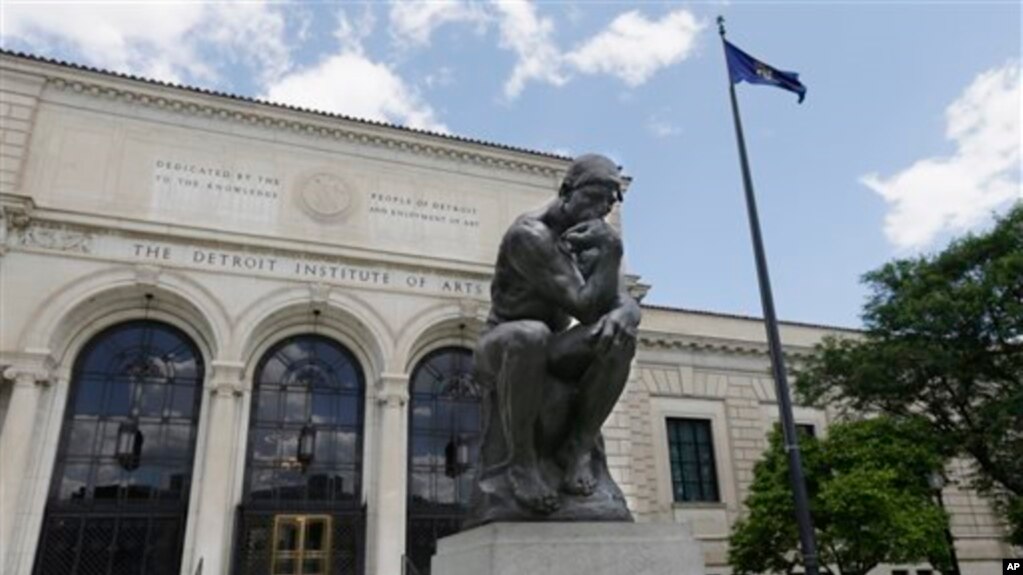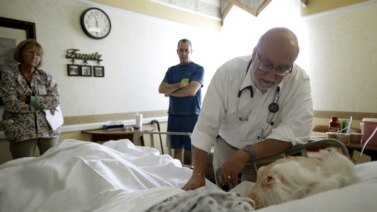
Welcome to American Mosaic from VOA Learning English.
I’m Kelly Jean Kelly.
On the show today, we play music from some singing nuns.
We also learn about a program that helps troubled women start new lives.
But first, we go Detroit, Michigan where some city residents are worried about the future of their famous art museum.
Art Lovers Worry About Detroit Museum Collections
The Detroit Institute of Arts museum in Michigan is home to valuable paintings, sculptures and ancient objects from around the world. But the collections belong to the city of Detroit. The city has requested bankruptcy court protection. Many people are concerned that the arts collections could be sold to pay some of the city’s debts. Avi Arditti reports.
Inside its huge rooms, more than 60,000 objects make up the Detroit Institute of Arts, or DIA for short. It is one of the most respected art collections in the United States.
Visitors to the museum can see Vincent Van Gogh’s brush strokes up close on his painting “Self Portrait.” They can also examine William-Adolphe Bouguereau’s “Nut Gatherers.” The work is so finely detailed, it looks more like a photograph than a painting.
But that is not what brought Virginia-based airline pilot Terrence O’Toole from Virginia to the DIA. He wanted to take a look at Diego Rivera’s large wall paintings of the Detroit automobile industry.
“And I thought it was interesting to come in here and see the murals depicting the diversity of the plant.”
Throughout the museum, many of the signs that describe each object share the same four words: “City of Detroit Purchase.” That is what makes the DIA different from most other major museums in America. The city of Detroit owns the DIA building and most of its collections.
Kevyn Orr is Detroit’s emergency manager. He asked about the DIA’s collections before he filed for bankruptcy protection for the city. The art world and many residents of Detroit were shocked and angered.
“It’s a slam against all the citizens of this city and a slam against the citizens of the whole area here.”
That is bookseller John King. He has lived in Detroit all his life. He remained in the city even as its population shrank. Mr. King says the DIA is important to what is left of Detroit’s spirit. He says he hopes those owed money by Detroit do not force the sale of the collection.
“It’s sad they’re even talking about going after that asset. I mean they have other assets they could go after, and they shouldn’t really be touching the Detroit Institute of Arts.”
Amiyatosh Purnanandan is a finance professor in the Ross School of Business at the University of Michigan. He says the total value of the DIA’s collection is far below the amount Detroit owes.
“You’re looking at $18 billion of debt. The art museum will fetch you one to two billion dollars. Even if you sell that, it’s not going to solve your problems.”
Pilot Terrence O’Toole adds that selling the collection would hurt tourism, the very thing Detroit needs rights now.
“It brings visitors, it brings cash flow to this community, which this city is in desperate need of some cash flow.”
The nonprofit group ArtServe Michigan says the state earned $2 billion from tourism in 2011. Visitors spent it mostly on cultural institutions, like the Detroit Institute of the Arts. Experts say selling the collection would harm more than just tourism. They say a flood of rare and important art onto the market could weaken Detroit’s ability to get the best price for the works.
"A Beautiful Place to Be"
Baltimore, Maryland, has one of the largest numbers of homeless people and substance abusers in the United States. About one-third of the city’s more than 4,000 homeless are women with drug abuse problems.
One organization that seeks to help those women is a place called Marian House. It has provided help toward recovery, including treatment and housing assistance, for more than 30 years.
“Heroin, cocaine, pills, whatever that would take me out of my own head, I had hit rock-bottom. Marian House is a beautiful place to be.”
Robin is one of the more than 1,000 women Marian House has helped to rebuild their lives. The center was established first as a temporary program for women coming out of prison. Today, it provides a helping hand for other women. Executive Director Katie Alston calls it a refuge.
“A home for women who are in need in the things that they’ve suffered through: Rape, domestic violence, sexual attack, mental illness, addiction. All of those things. A term that we’ve been using lately is a therapeutic recovery community.”

Cassaundra says she got to Marian House after a long struggle with drugs and alcohol. She tells what happened to her.
“Ultimately, I ended up in bad relationships, domestic violence. My last relationship … ended up with 29 stitches to the face, from the eyebrow down around to the neck.”
Cassaundra says it is hard to get into the center. Women are questioned before they can be admitted. They need to show that they are willing and ready to do something different. Cassaundra says when she did this, she had, in her words, “nothing left…absolutely nothing.” She says she needed Marian House desperately.
Katie Alston describes life at Marian House as like living in a dormitory for college students. But Ms. Alston says the center has strong rules.
“We have curfews, we have restrictions on visitors. We have an expectation, the first week they are on blackout. They can’t leave the building. After the first week, they have earlier curfews than they will later on.”
She says the women are expected to be involved in all required parts of the program. If they fail to attend a counseling meeting, they receive a written warning from a counselor.
Ms. Alston is happy about the women who complete the Marian House program. She says the program requires a great deal of bravery. She says some women often give up all of the life they have known.
Ms. Alston says there are thousands more women -- in the United States and overseas -- who need such a refuge but cannot find it. She says some women might not know a place like Marian House exists, while others might not be ready for such a program.
But she hopes that someday, women in need of help will find a place – and especially that those nearby will find Marian House.
The Singing Dominican Sisters
Marian House was begun by two groups of Roman Catholic nuns. Now, Christopher Cruise introduces you to some nuns who make music to better the world.
The choir is the Dominican Sisters of Mary, Mother of the Eucharist. It just released its first CD. “Mater Eucharistiae” is filled with holy music.
Mater Eucharistiae means “Mother of the Eucharist” in Latin. The Eucharist is something Catholics eat during a service. It usually starts as a piece of round, flat bread. Then a priest prays over the bread. Catholics believe this turns the bread into the body of Christ.
Here the religious workers sing “Adoro Te” which means I adore you.
The Dominican Sisters are perhaps the most famous Catholic religious workers in the United States. They have appeared on television several times, including two visits to the Oprah Winfrey Show.
They say they recorded the CD to “unite their voices to glorify God and the beauty of His holy Catholic Church.”
“It’s an opportunity to go into people’s homes and to go into their cars, you know, to, to bring some of what we are to them.” Sister Joseph Andrew is a leader of the group. She supervised the project, played the organ on some of the songs and wrote two, including this one, “Holy Mary Mother of God.”
The CD was recorded live at the group’s chapel in the city of Ann Arbor, Michigan. Sister Joseph Andrew told VOA the music represents the sisters’ Dominican spirituality, which they say they want to share with the popular culture.
“We’ve put a lot of ongoing prayer behind this. And, it would be our prayer that everyone who hears this is brought closer to God, has a more open heart for God’s love for each individual.”
I’m Kelly Jean Kelly. Our program was written Christopher Cruise and Caty Weaver, who was also the producer.
Do you have a question about American life, people or places? Send an e-mail to learningenglish@voanews.com. We might answer your question in a future show. You can also visit our website at learningenglish.voanews.com to find transcripts and audio of our shows.
Join us again next week for music and more on American Mosaic from VOA Learning English.




